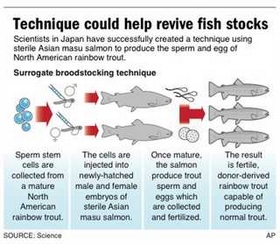 Remember the furor associated with the Trout Underground’s question whether a 43 lb triploid should be considered the new world’s record? That was an easy genealogy question compared to what’s coming.
Remember the furor associated with the Trout Underground’s question whether a 43 lb triploid should be considered the new world’s record? That was an easy genealogy question compared to what’s coming.
 Mature Stem Cells are harvested from trout, injected into the sterile Asian Masu Salmon, which upon maturity give birth to Rainbow Trout (eggs and milt of the trout, not live fish). Confusing? You bet – as they are using a live surrogate host of a different species to yield more trout spawn.
Mature Stem Cells are harvested from trout, injected into the sterile Asian Masu Salmon, which upon maturity give birth to Rainbow Trout (eggs and milt of the trout, not live fish). Confusing? You bet – as they are using a live surrogate host of a different species to yield more trout spawn.
I’ll leave the question of “New World’s Record” alone, but was I you I would start preparing for some really twisted DNA. Is a trout born of salmon a trout? Yep, this technique does not commingle DNA from the host fish to the offspring.
The scientists are using salmonids only as a first step towards increasing tuna stocks, once perfected they will find additional hosts for bluefin egg production.
It leaves an interesting unanswered question; could they possibly mix just a dab of the DNA? How about the 60mph swim speed and the 1400 lb max size genetic sequence … Imagine setting hook on a 12″ trout that melts your pawl and ratchet Hardy reel, oh my…
Technorati Tags: bluefin tuna, stem cell research, Masu salmon, salmonids

Sorry to burst your bubble, but it’s near impossible that any of the trout from these scientists’ labs would require taking a radar gun to the stream. Trout and salmon are built differently than tuna, marlin, and sailfish; salmonids max out at around 20 mph in sprints I believe. It’s just not in their DNA. There are most likely more than one gene determining speed and size. However I see this making a great Gierach story.
I haven’t read the journal article, but I’ll try to explain how it’s done. Step 1: Obtain specie you desire Noah of Ark style (at least one pair; dude and a lady) Step 2: From collected fish of importance, take a tissue sample, specifically the sperm and egg producing cells, respectively. Step 3: Grow collected cells in petri dish until desired number of cells has been reached. Step 4: Breed together some surrogate fish who will definitely produce sterile offspring. Step 5: Collect the sterile offspring eggs, grow, and wait for them to hatch. Step 6: Inject some of the gamete producing cells into newly hatched eggs. Step 7: Grow newly hatched fish to sexual maturity. Step 8: Breed the surrogates. Step 9: The surrogate offspring should be your desired specie.
There are two things that I’m not sure about. First, how did the scientists get the sperm producing cells into boy fish and the egg producing cells into girl fish? It’s important because I don’t think salmonids can switch sexes after fertilization, and once it came time for the fish to reproduce, the sex hormones it would naturally produce would affect the injected cells. Boy body with egg producing cells doesn’t mix. I don’t think it’s visibly apparent a fish’s sex at hatching. You could take a tissue sample from each fry and do some lab test for gender, but that seems rather labor intensive if this practice will ever be employed on a really large scale.
Secondly, and I know fish immune systems are less complex than our own, but how do you prevent the fish’s body from rejecting the injected cells? If there are any fisheries biologist reading who know the answer, I’d love to hear it. Thanks. Cameron D.
They just posted the story, here it is Cameron.
http://www.sacbee.com/832/story/377235.html
Better to have a science fiend explain the process than my halting attempt.